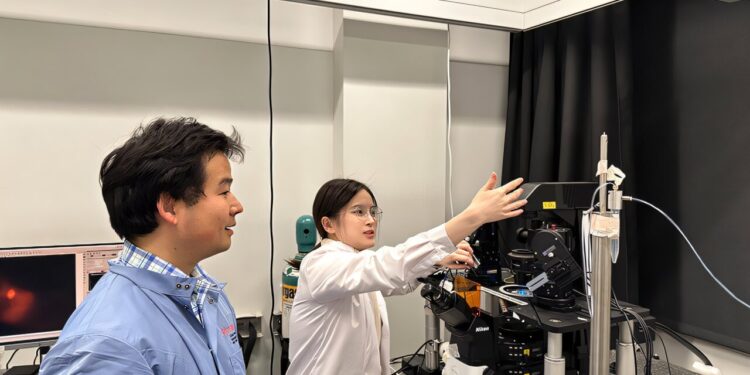The deputy professor of Rutgers University, Zheng Shi, and doctoral student Huan Wang, both from the Department of Chemistry and Chemical Biology, use specialized tools to explore the property of mysterious substances called biomolecular condensates. Credit: Zheng Shi / Rutgers University
An international collaboration of research led by Brunswick scientists from the University of Rutgers who examined microscopic stains of protein found in human cells discovered that some were transformed from an almost honey substance to a solid hard candy.
These mysterious droplets, known as biomolecular condensates, solidify when they carry a high proportion of alpha-synuclein protein, scientists report Scientific advances. Alpha-synuclein tufts are commonly found in the brain cells with Parkinson’s disease.
Scientists have declared that their discovery marks the first successful effort known to quantify the dynamics of condensates in living cells and highlights the importance of studying the mechanical properties of biomolecular condensates, which are linked to a wide range of biological functions and diseases.
“By measuring how these condensates change from liquid to solid in living systems, we can better understand how diseases like Parkinson are developing and progressing,” said Zheng Shi, deputy professor in the Department of Chemistry and Chemical Biology of the Rutgers School of Arts and Sciences and the main author of the study.
Over the past 15 years, scientists have used advanced technologies to obtain a detailed overview of biomolecular condensates, which have no membrane limit. They designated them as important to understand cell biology and the origins of the disease.
Rutgers scientists have focused on these microscopic protein spots in the hope of exploring new cellular mechanisms.
“Our study has enabled us to identify the factors that trigger the liquid transition to solid these condensates,” said Shi, who is also a member of the Rutgers Cancer Institute of New Jersey Rutgers Cancer program.
In Parkinson patients, brain cells that produce dopamine – a brain chemical that is crucial for movement control – die. The disease progresses over time, the symptoms aggravating as more neurons are lost.
Alpha-synuclein plays an essential role in Parkinson’s disease, because proteins are badly folds and tufts, forming pathological forms called Lewy body, which are toxic to neurons.
To make their results, scientists have developed a set of tools that would allow them to overcome the previous limitations which only allowed measures in test tubes.
“It is exciting because our technique allows, for the first time, a direct quantitative measure of the material properties of condensates in living cells,” said Huan Wang, doctoral student in the department of chemistry and chemical biology and the first author of the study. “It is a technological leap that opens up new ways to study the condensates of proteins.”
The key was to develop tools as tiny as the biomolecular condensates themselves which could probe the globs without destroying the cells that host these condensates.
The researchers created microscopic pipettes, called micropipets, to precisely measure the small volumes of liquids.
The technique took advantage of the hair effect, a physical phenomenon in which the liquid rises spontaneously or falls into a narrow space like a thin glass tube.
Scientists carefully inserted micropipettes into the condensates, pierce them and pull the liquid or a solid material inside. By controlling the pressure and observing how condensates deform and flow inside the micropipette, scientists have measured important properties such as viscosity (what is the thickness of a liquid) and the surface tension (how a liquid holds together).
The researchers said their goal was to continue to measure and better understand the properties of condensates in living cells and their implications for diseases.
“This opens up new ways for research on the first stages of neurodegenerative diseases and their treatment,” said Shi.
The Dragomir Milovanovic group at the site of the German center of the center for neurodegenerative diseases in Berlin also contributed to the study.
More information:
Huan Wang et al, quantification of living cells reveal viscoelastic regulation of synapsin condensates by α-synuclein, Scientific advances (2025). DOI: 10.1126 / SCIADV.ADS7627. www.science.org/doi/10.1126/sciadv.ads7627
Supplied by Rutgers University
Quote: Scientists reveal how a protein linked to Parkinson’s disease transforms biomolecular condensates (2025, April 18) recovered on April 19, 2025 from
This document is subject to copyright. In addition to any fair program for private or research purposes, no part can be reproduced without written authorization. The content is provided only for information purposes.



